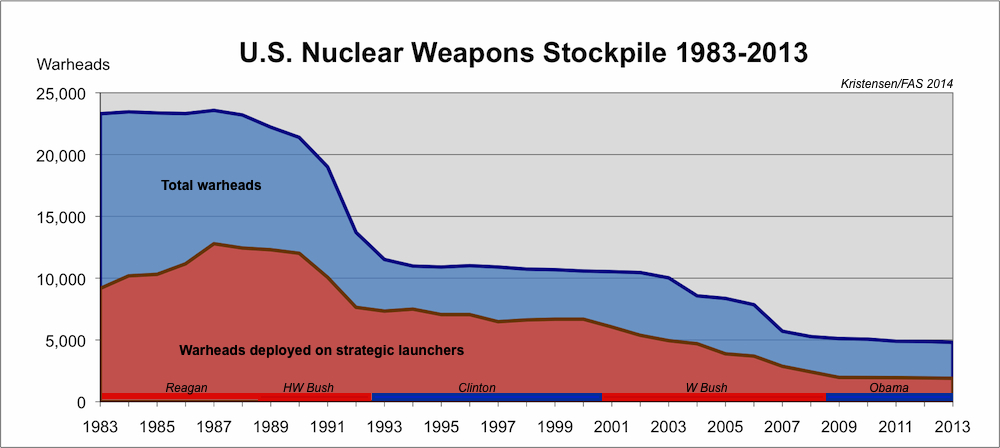US Nuclear Weapons Stockpile Number Declassified: Only 309 Warheads Cut By Obama Administration

The Obama administration has yet to make a visible dent in the U.S. nuclear weapons stockpile. Click on graph for larger format.
By Hans M. Kristensen
After a transparency hiatus of four years, the Obama administration has declassified the size of its nuclear weapons stockpile: 4,804 warheads as of September 2013.
The new stockpile size is 309 warheads fewer than the 5,113 warheads that the administration in 2010 reported were in the stockpile as of September 2009.
The new number of 4,804 warheads is 154 warheads more than Norris and I have in our latest Nuclear Notebook, in which we estimated a stockpile of 4,650 warheads. That estimate was, in part, based on the statement by Donald Cook, the NNSA administrator for defense programs, who in an email in February 2013 informed us that the reduction had been “approximately 85%” since 1967.
The new State Department announcement also mentions the “85 percent reduction,” although the 4,804 warheads actually correspond to a reduction of approximately 84 percent from the peak of 31,255 warheads in 1967. We thought 154 additional warheads had been retired, but apparently that will take a little longer.
What the declassification does not include, unfortunately, is a number for how many retired warheads are awaiting dismantlement. That number includes “several thousand” warheads, according to the fact sheet; we estimate approximately 2,500.
Timing is Everything
The declassification is timed with the opening in New York of the third preparatory committee meeting for the Nuclear Non-Proliferation Treaty. As a declared nuclear-weapon state party to the treaty, the United States needs to be able to demonstrate that it is living up to its obligations under the treaty’s Article VI to “pursue negotiations in good faith on effective measures relating to cessation of the nuclear arms race at an early date….”
Since President Barack Obama took office in 2009, the record shows the United States has:
* Reduced the nuclear stockpile by 309 warheads (roughly equivalent to the size of the entire French nuclear stockpile);
* Dismantled 1,204 retired warheads (more than the nuclear weapons inventories of France, China, Britain, Pakistan, India, Israel, and North Korea combined);
* Negotiated and signed the New START Treaty, limiting U.S. and Russian deployed strategic warheads to 1,550 by 2018, down from the 2,200 limit of the 2002 Moscow Treaty.
For the other nuclear-weapon states that have signed the NPT (Britain, China, France, and Russia) Britain and France have disclosed some stockpile numbers, although they were single year numbers and not the stockpile history like that of the United States. Both should disclose more complete histories of their nuclear stockpiles and dismantlements.
China and Russia have not disclosed anything but need to become more transparent about their stockpiles.
Implications
It is good to see that the administration has decided to declassify the stockpile and dismantlement numbers after 2009. It provides and official record that the United States is making progress (although slowly) in reducing its inventory of nuclear warheads.
Yet only 309 warheads fewer in four years! Not exactly the “dramatic” reductions promised by Barack Obama during the 2008 election campaign.
In fact, the numbers demonstrate one, for the Obama administration, uncomfortable fact: it has yet to make a noticeable dent in the stockpile. Big stockpile reductions over the past 30 years have all happened during Republican presidents (see table above). Although the Clinton administration dismantled over 11,000 retired nuclear warheads, it did not make significant reductions in the remaining stockpile or the number of warheads deployed on launchers. After the W Bush administration cut the stockpile nearly in half and offloaded more than half of the warheads deployed on strategic launchers, the Obama administration’s policies so far have had only a modest effect on the size of the stockpile and the number of warheads deployed on strategic launchers.
One reason is that the Obama administration has been opposed by a Republican Congress that has fought against nuclear reductions. But it is also because the administration itself has reaffirmed long-standing nuclear policy, protected the force structure, and emphasized modernizations of nuclear forces.
One would hope that the administration during its final four years would be bolder and seek to implement more reductions without Congressional approval of a new treaty. Clearly, much more can be done. Russia is already well below the New START limits and its nuclear forces are expected to decline further even without a follow-on treaty. Both Russia and the United States need to cut defense spending and both still have nuclear arsenals that are vastly in excess of national security needs.
While it is reasonable for governments to keep the most sensitive aspects of nuclear policies secret, the rights of their citizens to have access to general knowledge about these issues is equally valid so they may know about the consequences to themselves and their country.
Nearly one year after the Pentagon certified the Sentinel intercontinental ballistic missile program to continue after it incurred critical cost and schedule overruns, the new nuclear missile could once again be in trouble.
“The era of reductions in the number of nuclear weapons in the world, which had lasted since the end of the cold war, is coming to an end”
Without information, without factual information, you can’t act. You can’t relate to the world you live in. And so it’s super important for us to be able to monitor what’s happening around the world, analyze the material, and translate it into something that different audiences can understand.